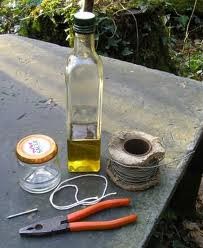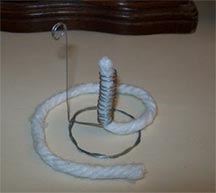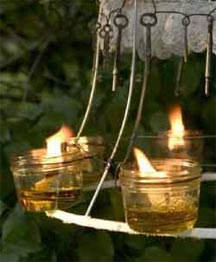Emergency Light from Your Kitchen!
By Alice Osborne
Emergency lighting is hiding in your kitchen? Absolutely, in the form of olive oil! Good friend, Nola, sent me an article from Mother Earth News recently on how to make olive oil lamps. Written by Deanna Duke, this very helpful information is paraphrased below.
 She reminds us that if we live in an area frequently experiencing power outages due to hurricanes, high winds and other storms, having back-up lighting on hand is a necessity. While candles are a sure bet, they don't offer much light and beeswax and soy candles can get expensive.
She reminds us that if we live in an area frequently experiencing power outages due to hurricanes, high winds and other storms, having back-up lighting on hand is a necessity. While candles are a sure bet, they don't offer much light and beeswax and soy candles can get expensive.
And there are drawbacks to hand-crank and battery-powered lanterns, as well as kerosene or other oil-style lamps as well. So olive oil is a better option - materials for this lamp are easy to acquire, inexpensive and gentle on the environment.
Olive oil lamps have been used for thousands of years and people have relied on oil lamps in general up until the last few generations. They are reliable, they burn bright and long, and if the lamp gets knocked over, it stops burning because it has a high flash point (it's not a very flammable material). As a result, an olive oil lamp is far safer than a candle or kerosene lantern.
 Minimal equipment is needed to make these, and if you don't have olive oil, other types of cooking oil, liquid fat or grease will work. The author says olive is a 99% pure renewable fuel that won't produce smoke or give off an odor, but she can't vouch for vegetable oils as being smoke-free or that they won't make the house smell like burnt popcorn.
Minimal equipment is needed to make these, and if you don't have olive oil, other types of cooking oil, liquid fat or grease will work. The author says olive is a 99% pure renewable fuel that won't produce smoke or give off an odor, but she can't vouch for vegetable oils as being smoke-free or that they won't make the house smell like burnt popcorn.
Making your lamp is relatively simple, and you'll likely have many of the materials on hand already:
•  A wide-mouthed glass jar (a quart-size wide-mouthed canning jar, or inexpensive jars from the dollar store will work well)
A wide-mouthed glass jar (a quart-size wide-mouthed canning jar, or inexpensive jars from the dollar store will work well)
• A short length of flexible steel wire, 11/2 or 2 times the height of the jar (spool of $1.59 floral wire from the craft store is perfect for this)
• A wick (100% cotton string or twine, such as a cotton mop head from the dollar store, salted to increase burning time)
• Olive oil (even rancid olive and vegetable oil can be used, so don't toss them out!)
 1. Form one end of the wire into a long hook, about the same height as the jar. This hook holds the wire on the jar and doubles as a handle to pull the wick up for lighting.
1. Form one end of the wire into a long hook, about the same height as the jar. This hook holds the wire on the jar and doubles as a handle to pull the wick up for lighting.
2. Wrap the other end of the wire into a coil, creating a wick stand about an inch or two tall that sits on the bottom of the jar.
 3. Thread about 2 inches of the salted wick up through the coil so that about a quarter inch or less of the wick is sticking up above the wire coil (any longer and the wick will smoke). The longer end of the wick will be soaking in the olive oil. To salt wicks, put your cotton twine in a bowl with a little water and cover the wick with table salt. Squeeze it dry and allow to thoroughly dry overnight, or until no longer damp. To get more light from your lamp, use a braided, flat wick (about 1/2 inch, adjusting the wire coil to tightly hold the wick - crimp it to accommodate the extra girth. Or, consider making wicks from a 100% cotton tea towel cut into strips.
3. Thread about 2 inches of the salted wick up through the coil so that about a quarter inch or less of the wick is sticking up above the wire coil (any longer and the wick will smoke). The longer end of the wick will be soaking in the olive oil. To salt wicks, put your cotton twine in a bowl with a little water and cover the wick with table salt. Squeeze it dry and allow to thoroughly dry overnight, or until no longer damp. To get more light from your lamp, use a braided, flat wick (about 1/2 inch, adjusting the wire coil to tightly hold the wick - crimp it to accommodate the extra girth. Or, consider making wicks from a 100% cotton tea towel cut into strips.
4. Add enough olive oil to your jar so that the level is just under where the wick is pinched by the wire. Any higher and you risk putting out the lamp with the oil. By using a canning jar, you can close the jar for storage with a canning lid, when the lamp is not in use. Various sizes of jars will work just fine by adjusting the size of the wick holder to fit the size of the jar. And author Duke used a canning jar lid with a hole punched in it to hold the wick instead of a wire coil to ensure the oil didn't spill.
Also, any (non-plastic) container can be turned into an oil lamp. In ancient times empty sea shells or even rocks with a slight indentation were used for this purpose. And actually, any natural fiber can be used as a wick.
 The Lamp Works by drawing the olive oil up the wick, where it vaporizes and gets burned by the flame. A few ounces of oil will burn for several hours, making it less expensive than most candles. And if you have problems with it smoking when blowing it out, use wet fingers to put out the flame, or just douse it with the oil in the jar.
The Lamp Works by drawing the olive oil up the wick, where it vaporizes and gets burned by the flame. A few ounces of oil will burn for several hours, making it less expensive than most candles. And if you have problems with it smoking when blowing it out, use wet fingers to put out the flame, or just douse it with the oil in the jar.
If you'd like to fancy things up, you can infuse your olive oil with herbs, spices or essential oils for a more scented experience.
 And speaking of fancy, another clever person created an olive oil lamp chandelier out of a discarded lamp shade frame. I didn't find instructions on how to secure the jars to the shade base, but I bet we could figure it out!
And speaking of fancy, another clever person created an olive oil lamp chandelier out of a discarded lamp shade frame. I didn't find instructions on how to secure the jars to the shade base, but I bet we could figure it out!
 Finally, author Duke suggests finding the little book, I Didn't Know that Olive Oil Would Burn (from Lehmans.com for $3.50), to find out more about how to join this movement towards a safe and environmentally sound way to ensure you have light during emergencies. Emergency light from your kitchen - who knew?
Finally, author Duke suggests finding the little book, I Didn't Know that Olive Oil Would Burn (from Lehmans.com for $3.50), to find out more about how to join this movement towards a safe and environmentally sound way to ensure you have light during emergencies. Emergency light from your kitchen - who knew?

